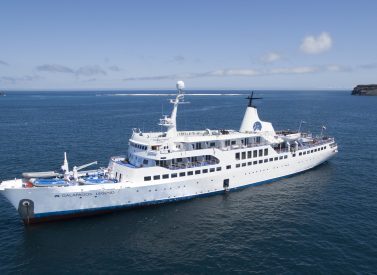
Solaris First-Class Galapagos Motor Yacht
Solaris offers a modern, first-class Galapagos Islands cruise.
If its spacious cabins and panoramic windows weren’t enough, the boat is perfect for solo travellers because there is no single supplement!
Fantastic itineraries and top guides lead the action, with plenty of time to reflect on the wildlife and natural wonders you’ll encounter.
Whether it be a Galapagos holiday for one person, a couple, family, or friends, Solaris delivers a first-class Galapagos travel experience.
Solaris Yacht Galapagos Cruise
The Solaris has three excellent itineraries to choose from:
- A seven-day loop of the magnificent western islands
- A five-day exploration of the remote north and wildlife-rich central islands
- A further five-day trip that visits the beautiful eastern and southern islands
Solaris is famous as a single cabin cruise option for the Galapagos Islands. The yacht’s owners don’t charge extra for those holidays for one person — with no single supplement to pay.
The Solaris’ beautiful communal spaces encourage you to stay up deck to view the Galapagos’ wildlife. But you can easily do the same through your beautiful cabin’s panoramic window when you need some downtime, too.
Choose a solo cabin, twin, double, or a family triple — Solaris stands out and receives rave reviews thanks to the quality of its staff, rooms, itineraries, and standards.
Trip Highlights
Print Share Download as PDF-
Single cabin cruises — up to five Ocean View cabins on every sailing for solo travellers with no single supplement payable
-
Three itineraries that maximise wildlife viewing, snorkelling, and island exploration
-
Spacious cabins with ocean views
-
Remodelled in 2021 to make it one of the most up-to-date first-class motor yachts in the Galapagos
-
Bathrooms equipped with complementary eco-friendly soaps and shampoos
-
Delicious international and local cuisine from the boat’s talented chef
-
Two-person kayaks free to use
Tom always got back to us really quickly, answered our questions clearly and gave us lost of really useful information and details. We were very impressed.
It gave us so much confidence in Andean Trails, unlike other replies we got from other agents, which were also much slower.
We decided to travel with you because of Tom’s efficiency and friendliness.
J Fairweather, UK, Legend Cruise
Full Itinerary
Itinerary A: Western Islands
Itinerary A (7 days) Tue-Mon
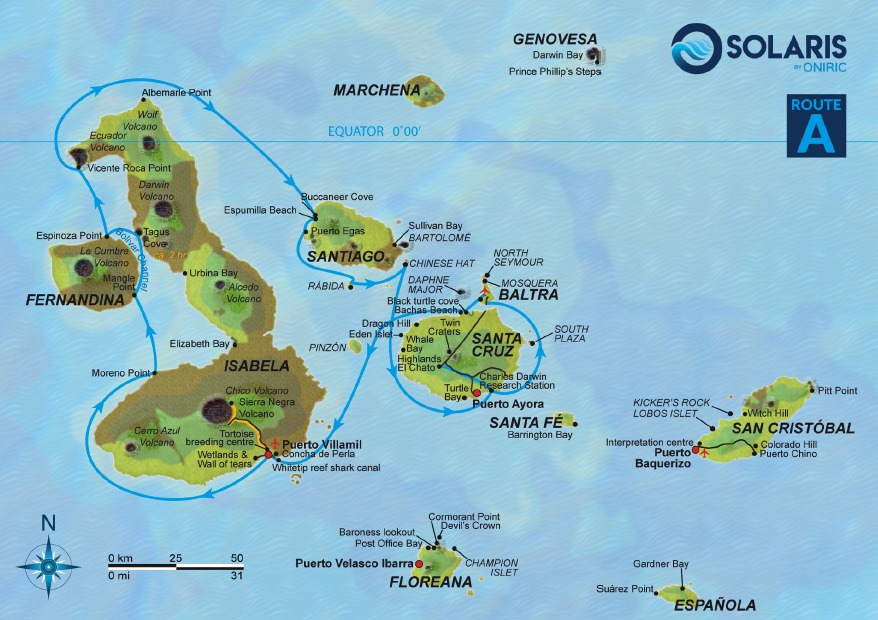
- Remote islands of Fernandina and Isabela, with their unique volcanic formations.
- Snorkel with white-tip reef sharks, sea turtles, sea lions and colourful reef fish.
- Look for Galapagos tortoises in their natural habitat.
- Thirteen walks, ten snorkels, and eight dinghy rides.
Day 1 (Tue): Fly to Baltra, transfer to Solaris yacht – Bachas (L,D)
Upon arrival at Baltra airport, you pass through an airport inspection point, pay the park entrance fee of USD 100 (unless it has been prepaid), meet your guide, and collect your luggage.
Next, we head to the harbour to board the first-class motor yacht Solaris. The crew and captain greet you, followed by cabin assignment and lunch aboard your new home.
Bachas (Santa Cruz)
Bachas is formed of two small beaches found west of Turtle Cove. Their sand is made of decomposed coral, which makes it white and soft, making it a favourite nesting site for sea turtles. There is a small brackish water lagoon behind one of the beaches, where occasionally we see flamingos and other coastal birds, such as black-necked stilts and whimbrels.
There’s a chance to enjoy your first snorkel here, too.
Day 2: Isabela: Tintoreras – Wetlands – Wall of Tears – Tortoise Breeding Centre (B,L,D)
Tintoreras (Isabela)
Tintoreras consists of several small islets off the coast of Puerto Villamil and is one of the most emblematic visitor’s sites of the Galapagos. You can see herons on mangrove branches whilst Galapagos penguins, and sea lions wander the land. White-tip reef sharks swim in the tidal channels, and their abundance is what gives these islets their Spanish name. Another highlight is the breeding colony with uncountable numbers of marine iguanas.
Before returning to the boat for lunch, we enjoy a short hike among the wildlife and a snorkel.
Wetlands, Wall of Tears and tortoise breeding centre (Isabela)
We set off to visit the local tortoise breeding centre, where hundreds of giant Galapagos tortoises of all sizes can be seen. The vulnerable hatchlings are smaller than the size of your hand!
Next, we head to The Wall of Tears. On this national cultural heritage site, prisoners built a long and pointless wall from lava rocks as punishment. There follows some free time to explore the laid-back village of Puerto Villamil and its beach.
Day 3: Moreno Point – Tagus Cove (Isabela) – Punta Mangle (Fernandina) (B,L,D)
Moreno Point (Isabela)
Moreno Point is located on the north coast of Isabela Island, between the volcanos Sierra Negra and Cerro Azul. The trail runs along a solidified pahoehoe lava flow into a complex of coastal lagoons. Its main attractions are several species of birds found around the lakes and mangrove forests.
We also jump into the water for a snorkel and return to the boat for lunch.
Tagus Cove (Isabela)
The boat ride to Tagus Cove shows how eruptions have formed the characteristic horseshoe shapes of Tagus Cove. Sailors used to write their vessels’ names on this place’s eastern cliffs.
A tour along the cliffs in a dinghy will give the visitors an excellent chance to see the Galapagos penguin, the flightless cormorant and other sea birds. After landing, we hike 30 minutes along a trail up to the top of the cliff for excellent views over Darwin Lake. The vista includes several volcanoes. Look carefully at the graffiti on the surrounding cliffs of the cove, written by pirates, whalers and buccaneers.
Day 4: Punta Espinoza (Fernandina) – Punta Vicente Roca (Isabela) (B,L,D)
Punta Espinoza (Fernandina)
Fernandina is the third-largest island in the archipelago. Punta Espinoza has one visitor site located at the northeastern tip of the island. Marine iguanas bask in large numbers, swim near the shore and sunbathe on the landing dock.
We’ll enjoy a fantastic snorkel here with the right sea conditions before returning to our boat for lunch.
Punta Vicente Roca (Isabela)
We sail to Vicente Roca Point during lunch, to the mouth of Isabela’s seahorse shape. The dinghy takes us into a dark cave below a spectacular arch, accompanied by the roaring echoes of crashing waves.
The calmer waters of the coves are well protected against the ocean swell. They are a reasonably cold but great place for snorkelling amongst various species of shark, penguins, pufferfish and even seahorses.
Day 5: Espumilla Beach - Bucaneer Cove – Puerto Egas (Santiago) (B,L,D)
Espumilla Beach, Bucaneer Cove (Santiago)
Espumilla Beach lies at the northern end of James Bay, on the western coast of Santiago, an important breeding site for turtles. The turtles return yearly to bury their eggs in the cinnamon-coloured dunes.
The beach ridge hides mangroves that surround two picturesque lagoons. We hike to the top of a hill for a beautiful view. Return to the sea for a snorkel, then to the boat for lunch.
Puerto Egas (Santiago)
During lunch, we sail south to Puerto Egas, with its famous fur seal grottos. The coastline walk is lovely. Masterfully-sculptured black basalts and polished multi-coloured ash layers make for beautiful photographs of collapsed lava tunnels, natural arches, caves and blowholes.
A giant sea lion colony lives here among seemingly countless sally lightfoot crabs. We’ll enjoy a quick snorkel before returning to the boat.
Day 6: Rabida – Chinese Hat (B,L,D)
Rabida
Today we start on the fabulous red beach of Rabida for two short guided hikes. Oxidised iron particles give the rocks and sand their rusty colour. This oasis is the most fertile place on the otherwise arid islet, overgrown with leaf-dropping palo santo trees. The salty pool attracts aquatic birds, like pintails and sometimes American flamingos.
One of the most outstanding attractions is the primary breeding colony of brown pelicans, the only ones in the world that plunge-dive. There’s time for a snorkel before heading to the boat for lunch.
Chinese Hat
Chinese Hat is a 52 m/170 ft high volcanic cone forming an islet off the rocky coast of Santiago. A small colony of Galapagos penguins has settled here. Chinee Hat is an excellent place to learn more about volcanism, lava bombs and tunnels due to its recent extinction.
We can see how barren lava fields become fertile through erosion and with a helping hand from Galapagos sea lions and countless marine iguanas. We enjoy the last snorkel on this trip before dinner aboard the boat.
Day 7 (Mon): Charles Darwin Research Station, transfer to Baltra airport, ends (B)
Our last visit today and it’s to the iconic Charles Darwin Research Station and the headquarters of the Galapagos National Park Service.
There is an educational stroll with a stop at the successful breeding centre and the enclosure of the Galapagos giant tortoises.
From here, you head to Baltra airport for a flight back to the Ecuador mainland, continue your cruise, or stay on the islands in a hotel.
Itinerary B: Northern Islands
Itinerary B (5 days) Mon-Fri
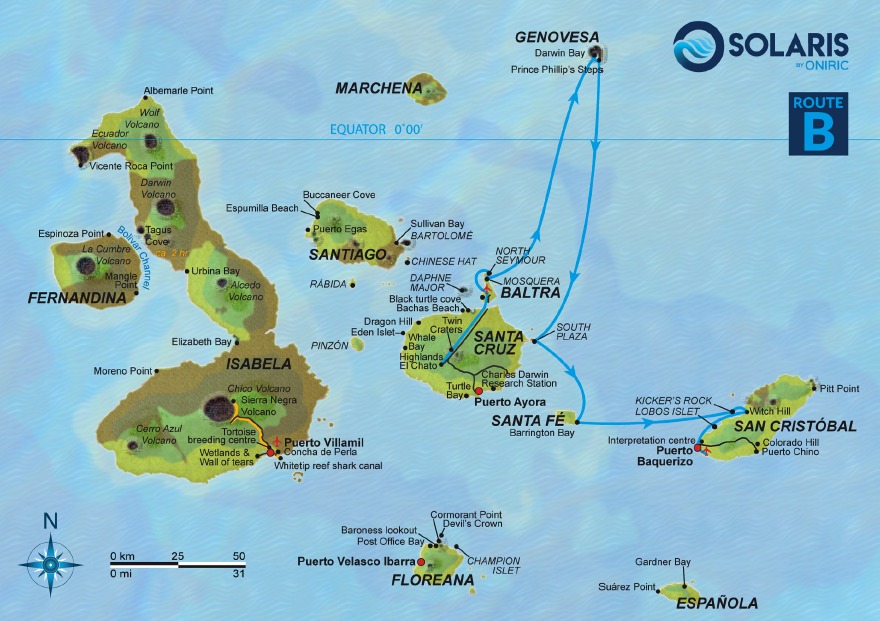
- Visit the remote jewel of Genovesa
- See Galapagos’ largest sea lion colony at Mosquera
- Sail past the iconic Kicker Rock
- Four snorkels and two hikes
Day 1 (Mon): Fly to Baltra, transfer to Solaris yacht – Santa Cruz Highlands (L,D)
Upon arrival at Baltra airport, you pass through an airport inspection point, pay the park entrance fee of USD 100 (unless it has been prepaid), meet your guide, and collect your luggage. Next, we head to the harbour to board the first-class motor yacht Solaris. The crew and captain greet you, followed by cabin assignment and lunch aboard your new home.
Santa Cruz Highlands
We start the trip searching for Galapagos giant tortoises in their natural environment of the Santa Cruz Highlands. The path can be a bit muddy, so be prepared for a few slips and slides as we look for the tortoises.
We also visit The Twin Craters, impressive formations formed from magma domes. The craters lie within a lush scalesia cloud forest, a high-altitude plant species endemic to the Galapagos. Keep your eyes peeled for carpenter finches and the vermillion flycatcher.
Day 2: North Seymour – Mosquera (B,L,D)
North Seymour
Seymour is an uplifted (as opposed to volcanic) island, mainly flat and strewn with boulders. The island hosts a large population of magnificent frigate birds and Blue-footed boobies while swallow-tailed gulls perch on the cliff edges.
Sea lions haul out onto the beach and can be found bodysurfing. They may even playfully approach you while we snorkel before heading to the boat for lunch.
Mosquera
Mosquera offers beautiful white coral sand beaches and gorgeous blue water that has attracted many sea lions. We’ll walk among them and many birds, then enjoy a snorkel before boarding the Solaris for dinner, ready to sail northwards.
Day 3: Darwin Bay – Prince Phillip’s Steps (Genovesa) (B,L,D)
Darwin Bay
Darwin Bay lies inside the submerged caldera of Genovesa lies Darwin Bay, with a diameter of more than 1.5 km/1 mi and 200 m/650 ft deep. Genovesa is a stunning island with a coral sand beach, barren lava formations and creeks, tidal pools, shrubs and dramatic cliffs.
There are many birds to see, from whimbrels and wandering tattlers to frigatebirds and red-footed boobies. Your guide can point out the yellow warbler and hopefully the different birdsong between singing cactus finches. There’s an exciting snorkel followed by lunch aboard the Solaris.
Prince Phillip’s Steps
Before landing at Prince Philip’s Steps, a dinghy ride along the eastern arm of the caldera gives us a great glimpse of the island’s soaring 25 m/80 ft high walls.
We land and hike up some steep stairs to reach the top of the cliffs for our walk among Palo Santo shrubs and various birds. Many birds will fly close overhead, a thrilling experience. With luck, a short-eared owl will be hunting for food!
A final snorkel, and we head back to the Solaris yacht for dinner after a spectacular day in one of the Galapagos’ best islands.
Day 4: South Plaza – Santa Fe (B,L,D)
South Plaza
South Plaza is the best place to encounter endemic Galapagos land iguanas, who do make patient and photogenic models. Clouds of petrels, storm petrels, shearwaters and brown noddies make spectacular flights from our viewpoint. Be sure to bring binoculars and a well-charged camera.
Lunch aboard the Solaris Yacht.
Santa Fe
Santa Fe is in the southeastern part of the Galapagos, formed by uplift. Some argue it is the oldest island in the archipelago. What is known is that Santa Fe is the home of several endemic species like the Galapagos hawk, Galapagos snake, Galapagos mockingbird, and one of the two species of land iguanas of the islands.
The beautiful clear waters offer a lovely snorkel. There are two beautiful beaches where sea turtles live, plus a colony of Galapagos penguins.
Day 5 (Fri): Kicker Rock – Witch Hill – transfer to San Cristobal airport (B)
Kicker Rock, Witch Hill
Kicker Rock is one of the Galapagos’ iconic formations, a vast offshore block of rock with a tower next to it.
It rises about 150 m/500 ft straight from the sea. From one side, it looks like a giant shoe, hence its name. From another angle, it looks like a sleeping lion, hence its Spanish name, Leon Dormido, which means sleeping lion.
We sail around this formation on the way to San Cristobal. Keep an eye out for octopi, sharks and Pacific green turtles. We land at San Cristobal and head to Witch Hill. This coral sand beach is home to many birds, sea lions, and marine iguanas. The people of Puerto Baquerizo Moreno used to use a nearby lagoon as a salt mine.
From here, you head to San Cristobal airport for a flight back to the Ecuador mainland, continue your cruise, or stay on the islands in a hotel.
Solaris Itinerary C
Itinerary C: Southern Islands
Itinerary C (5 days) Fri-Tue
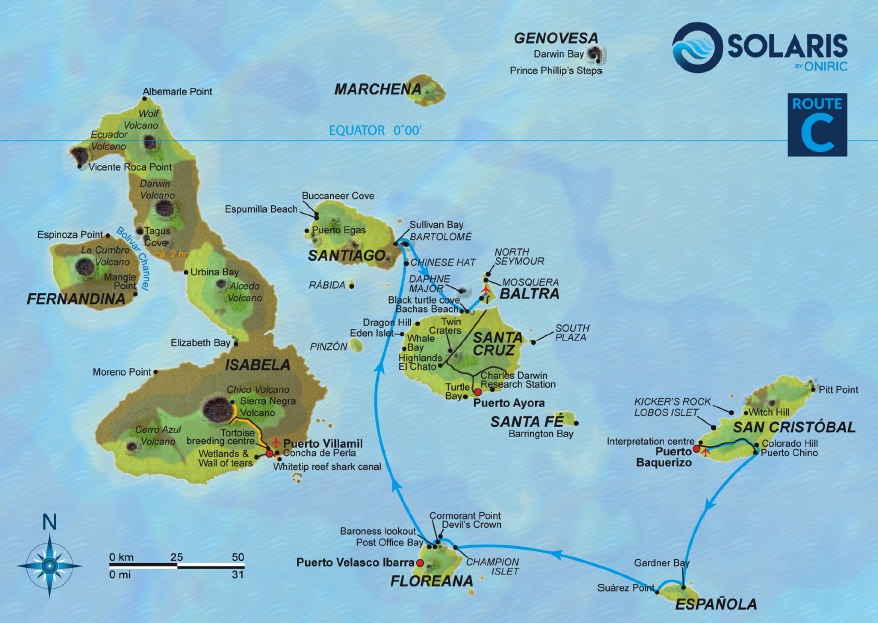
- Visit the iconic and beautiful Bartolome.
- Snorkel with playful sea lions, colourful reef fish and Pacific green turtles.
- Send cards at the historical Post Office Bay.
- Explore emerald lagoons, swim with penguins
- Four snorkels and five hikes
Day 1 (Fri): Fly to San Cristobal, transfer to Solaris yacht – Colorado Hill (L,D)
Upon arrival at San Cristobal airport, you pass through an airport inspection point, pay the park entrance fee of USD 100 (unless it has been prepaid), meet your guide, and collect your luggage.
Next, we head to the harbour to board the first-class motor yacht Solaris. The crew and captain greet you, followed by cabin assignment and lunch aboard your new home.
Colorado Hill
Colorado Hill is home to Cerro Colorado Tortoises Protection and Growing Centre, built to increase the local populations of island tortoises. Learn about the breeding programme and see tortoises while looking out for birds like the San Cristobal mockingbird, yellow warblers, many species of finches and the Galapagos flycatcher.
Day 2: Gardner Bay and Suarez Point (Española) (B,L,D)
Gardner Bay
Gardner Bay lies on the north-eastern coast of the island of Española.
It is a fantastic place to enjoy turquoise seas and snorkel among many colourful reef fish, green sea turtles, and playful Galapagos sea lions. The white sand beach is also an important breeding ground for the green sea turtles. We return to the Solaria Yacht for lunch.
Suarez Point
The southern basaltic cliffs of Suarez Point act as a buffer to substantial ocean waves that come crashing in. The result is a spectacular blowhole, spraying seawater many metres high into the air — a place to meditate and relax.
Our walk on this rocky area takes us past some of the archipelago’s most impressive and diverse seabirds. Galapagos albatross, blue-footed and Nazca boobies, swallow-tailed gulls, red-billed tropicbirds, and more make this home at certain times of the year. Return to the Solaris for dinner.
Day 3: Cormorant Point - Champion Islet - Post Office Bay - Baroness Viewpoint (Floreana) (B,L,D)
Cormorant Point and Champion Islet
Floreana’s northern cape is where the peninsula of Cormorant Point lies.
We land at a beach to be greeted by a small Galapagos sea lion colony. It’s not any old beach, though — it’s green because it contains a high percentage of glassy olivine crystals.
On the other side of the peninsula lies a more delicate, white coral sand beach, smooth on the feet. Pacific green turtles come here to bury their eggs early in the year.
Our snorkel today is at the emblematic Devil’s Crown, one of the best snorkelling spots in the Galapagos. Its coral reef centre attracts a lot of marine life, from Galapagos penguins to sea lions, sea turtles to colourful fish, and maybe even some dolphins. Note that the current can be a bit strong sometimes. Return to the boat for lunch.
Post Office Bay and Baroness Viewpoint
A whaling ship crew left a wooden barrel at this spot in the 18th century, starting a tradition that carries on today.
Any passing ships would take the letters and which would be delivered by sailors returning home, and no postage fee was required.
The beach is home to Galapagos sea lions, Pacific green turtles and golden rays, and you may see Galapagos penguins. We’ll enjoy great views from the Baroness Lookout and then a snorkel.
We have a long sail once back on the Solaris for dinner, so you may want to take some seasickness medication as a precaution.
Day 4: Sullivan Bay (Santiago) - Bartolomé (B,L,D)
Sullivan Bay (Santiago)
Sullivan Bay is as close to a moon landing as you’ll find on earth. Despite its desolate, lifeless appearance, this island is popular among photographers.
There is life, too — green sea turtles burrow into the small white sand beach, where you can also find crabs, blue herons and oystercatchers.
Return to the Solaris yacht for lunch.
Bartolomé
The beautiful volcanic islet of Bartolomé (Bartholomew in English) is among the youngest of the islands. It offers some of the wildest landscapes and best panoramas of the entire archipelago.
We’ll need to climb 114 m/375 ft to enjoy the postcard-perfect view of the idyllic Pinnacle Bay. There’s also a fantastic snorkel in the protected bay before our return to the boat for dinner.
Day 5 (Tue): Black Turtle Cove – transfer to Baltra airport (B)
Black Turtle Cove
Black Turtle Cove feels more like the Amazon rainforest than the Galapagos, with its verdant vegetation and emerald lagoons.
We explore the cove by dinghy, hopeful of spotting white-tip reef sharks, black-tip reef sharks, hammerhead sharks, gold rays and spotted eagle rays in the crystal clear waters.
From here, you head to Baltra airport for a flight back to the Ecuador mainland, continue your cruise, or stay on the islands in a hotel.
Prices From $4,050 / £3,293 per person
What's Included?
Accommodation in single (no supplement), double, twin, or triple cabin, bilingual naturalist guide (English-Spanish), all meals from lunch on the first day to breakfast on departure day, free purified water, tea, and coffee, visit as per itinerary, shared Galapagos transfers airport-yacht-airport, snorkelling gear (mask, tube, and fins), kayaks, eco-friendly shampoo and soaps, room or beach towels, shared transfer to Quito or Guayaquil airport on day 1 if the Galapagos flight has been booked via the boat.
What's Not Included?
International flights, Round trip flights to the Galapagos Islands, Galapagos National Park fee, Galapagos Ingala fee, soft and alcoholic drinks, personal items, souvenirs, tips, travel insurance, personal items, Ecuador services, wetsuit hire
Accommodation
The Solaris was built in 2019 and completely remodelled in 2021, making it one of Galapagos Islands’ newest and most up-to-date first-class yachts.
The boat has up to twelve spacious cabins with large panoramic windows and private bathrooms with hot and cold water and hair dryers. Electricity is 110V / 220V.
However, Solaris sails with a maximum of 16 passengers because it offers up to five cabins on each sailing with a single supplement for solo travellers.
Cabins
There are six main deck cabins in total.
Five of them measure 12m2, and four of those are single cabins with single beds. The remaining 12m2 cabin has a twin/matrimonial bed.
The sixth cabin on the main deck measures 23m2 and can be used as a twin, matrimonial, or triple cabin.
There are five upper deck cabins, each measuring 23m2.
Three of these cabins have a queen bed and single bed arrangement.
The remaining two have a queen bed and sofa bed distribution.
Communal areas
Communal areas include a modern and comfortable interior living/dining room with a tea/coffee station, flat-screen home cinema, DVD player and a small library. A spacious sun deck is perfect for wildlife watching, sundowners, reading, or writing your travel diary.
Tour Staff
The crews are “Galapagueños”, guides, captains and crew members were born and raised in the Galapagos Islands.
The Naturalist, English-speaking guides have studied and been trained at Charles Darwin Scientific Station, and have long years of experience guiding at the Galapagos Islands.
Without doubt your on-board naturalist guide is the crucial pivot for your experience in the Galapagos. Solaris guides use their extensive experience to lead the excursions, to search and identify species and point out interesting details; besides taking care of your safety and compliance of indispensable conservation rules.
Above all our guides share their knowledge, love and respect for the Galapagos’ stunning ecosystem. Their explanations (in English and Spanish) and fascinating stories about animal behaviour, intriguing ecosystems and survival strategies can bring nature even more to life; not only in the field, but also during lectures or daily briefings aboard.
There will be a total of 9 crew aboard the Solaris looking after your needs in Galapagos.
Meals
A professional cook and kitchen staff will treat you to a substantial breakfast and mouth-watering warm lunches and dinners, all served in abundant buffet style.
All departures include vegan and vegetarian options as long as you let us know well before the sailing.
There is a varied menu of local and international dishes with a choice of two meals at lunch and dinner. Breakfast is buffet-style. Food is healthy and delicious, and snacks and juices are served in-between meals.
Free drinking water is available in the lounge 24 hours a day. Bathroom water is desalinated and unsuitable for drinking; desalination helps protect precious freshwater resources on the Galapagos Islands.
Activity Level
Walks
Every visit to each island involves an easy or moderate walk, which can last between 2 to 3 hours, and are not considered strenuous. On these walks you will be led by an expert naturalist guides in a small group along clearly marked trails. They will explain in great detail all the wonders of each of our carefully selected itineraries. Most days there are two guided walks on a specific island where you will be able to walk and hike on beaches, lava fields, alongside cliffs and around mangrove estuaries.
Snorkelling
Snorkelling in the Islands is the highlight of the Galapagos cruise for many of our guests. You have the opportunity to go snorkelling almost every day – snorkelling with marine iguanas and with playful sea-lions are some of the highlights, as well as with green sea turtles, penguins and an incredible variety of colourful reef fish. On the western islands the water is a little colder but teaming with life. There are beach snorkels for beginners and deeper waters.
Zodiac rides
Dinghies, or “Pangas” as they are known in Galapagos, are inflatable zodiacs that serve as the main transportation method from our Galapagos yachts to the visitor sites. At several times during your week-long Galapagos travel adventure, you will have the chance to enjoy dinghy (or panga) rides in shores, mangrove estuaries, coves and caves.
Practical Information
Is this the cruise for me?
The first-class motor yacht Solaris is perfect for families and adventure travellers, but especially for single travellers who want to avoid supplements.
This solo traveller-friendly boat offers up to five single ocean view cabins without a supplement on every sailing.
Introduction to Galapagos
These magical islands comprise of 50 volcanic islands of varying shapes and sizes, which lie 1,000 kilometres off the coast of Ecuador.
Here, unlike anywhere else on Earth, you can enjoy a thousand close encounters with a weird and wonderful variety of ‘friendly locals’, including giant tortoises, fur seals, sea iguanas, frigate birds and blue-footed boobies.
Read our Galapagos Islands Guide and more about diving.
In 1535, Tomás de Berlanga, Bishop of Panama, floated into this archipelago and named it Galapagos after the giant tortoises he encountered. Pirates used the islands for refuge and to bury their stolen treasure after that.
The islands’ most celebrated visitor was Charles Darwin, who arrived aboard the HMS Beagle in 1835. The rare life forms he encountered helped him formulate his theory of evolution, which he published in The Origin of Species by Means of Natural Selection.
It wasn’t until 1959 when it became part of Ecuador’s national park system that this fragile ecosystem with its rare and endemic species came under protection.
In 1979 the Galapagos archipelago was declared a UNESCO World Heritage Site.
Weather in Galapagos
When to visit Galapagos Islands: weather and wildlife
There is no real ‘best’ time to visit Galapagos on holiday as there is always wonderful wildlife and weather to enjoy. Read our blog for more.
Most animals – tortoises, sharks, sea lions and boobies – are found year round and many of the species here are non-migratory.
The Galapagos Islands are located right on the equator so air and water temperatures do not vary by much.
Having said that, there are two recognised seasons, and each months brings natural marvels for the visitor to enjoy.
Below is our quick guide to the weather and wildlife you can find on the Galapagos Islands.
General weather information
The warm season (Jan-Jun)
- Calm, clear warm waters, great for snorkelling, often without a wetsuit.
- Great weather, with February and March being the hottest and sunniest months with blue skies and sunshine.
- Occasional heavy bursts of rain in the afternoons.
Sea temperatures: 22-25°C / 72-77°F
Land temperatures: 21-32°C / 72-90°F
The dry ‘garua’ season (Jun-Dec)
- It’s a great time for marine life in the cooler seas. Snorkellers may want a wetsuit.
- August and September the coolest when you may need a jacket in the evenings and the sea can be choppy.
- There can be mist on the islands in the mornings (garua) which usually burns off by midday leaving overcast skies or a sunny afternoon.
Sea temperatures: 15-22°C / 60-72°F
Land temperatures: 18-24°C / 65-75°F

Air and sea temperatures in Galapagos, month-by-month
Galapagos cruise kit list
Good kit is vital for every trip.
Book with Andean Trails and get 15% off Páramo’s fantastic ethical and high performance outdoor gear.
Galapagos – general advice
Galapagos is warm and humid, and you will need t-shirts (moisture wick-away or breathable t-shirts can be very useful, it can get very hot in the day), shorts, lightweight skirt or trousers and bathing suits.
One or two cotton shirts can be used to protect you from sunburn, especially when snorkelling (not very elegant worn in the water over a swimsuit, but practical – and Galapagos is NOT an elegant place!).
You may want to change into different clothes for the evening, but don’t take anything dressy or smart – there really is a very relaxed atmosphere on board.
Pack something warm for going on deck in the early morning or evening a fleece, maybe, and a sweatshirt – and a waterproof for the Highlands.
Strong sandals, trainers, or light hiking boots are ideal footwear – you may like to have something suitable for easy walks and another for tougher terrain – your guide will advise you daily what the walking will be like. Most boats ask passengers not to wear heavy shoes on board.
Do take a hat!
Seasickness tablets if you think you will have problems – i.e. Sturgeon, or Mareol if you buy them in Quito. The sea can be choppy, so it is recommended to take them as a precaution.
Galapagos – detailed kit list
- First aid kit – aspirin, imodium, sun tan lotion (facter 50 recommended), sunburn cream, lip salve, throat lozenges, insect repellent, etc.
- Earplugs – the engine can be noisy, whatever the boat, wherever your cabin.
- Sun glasses and sun hat.
- Snorkelling equipment – the boat either provides kit for free or has a supply for hire, but it may suit you better to take equipment in your size that you know will fit you. Even if you have not snorkelled before, DO have a go – under water Galapagos is a very special experience. Try it first of all from the beach, to get the hang of breathing through gritted teeth, then take the plunge!
- Towel, for the beach (most boats provide these, please ask).
- Money belt.
- Passport, with at least 6 months remaining from date of return from Ecuador.
- US Dollars cash and mixed denomination notes, undamaged and unmarked.
- Visa/MasterCard, Cash card.
- Personal & Medical insurance.
- Camera and film / memory cards (take at least twice the amount you think you will need!). You may want to take an underwater camera for snorkelling.
- Camera charger
- Binoculars
- Small backpack – to keep your sun cream, water, shirt etc in when you are on shore.
- Small plastic water bottle, 1-2 litres, depending on how much you drink.
- Biodegradable sunblock (v. high factor, 50+ recommended) and lip salve.
- Toiletries (featuring biodegradable soap).
- Wet Wipes/antiseptic hand wash cream
- Travel alarm clock.
- Sewing kit.
- Spanish/English phrasebook.
- Book, e-book, mp3 player/ipod or other for free time.
The Galapagos Islands are a very fragile environment and the arrival of more and more inhabitants to the islands, as well as tourist have an impact.
Please try to minimise your impact by:
- Bringing a water bottle to refill, rather than using a new bottle each time.
- Recycling your rubbish where possible, not leaving any rubbish behind.
- Taking batteries back home with you – they cannot be recycled properly in Ecuador.
- Saving water where possible.
- Leave toiletries that contain microbeads at home
- Saving energy by switching your lights off when you leave the room. Electricity on the islands comes from a generator, fuelled by petrol. For this same reason, please think about whether you really need to use your air conditioning.
Quito
Pleasantly warm during the day, but can be quite chilly during the morning or at night when you might want a jacket or a fleece, plus a waterproof.
You may want to dress up a little more in the evening here, depending on where you are staying, and what sort of restaurant you like.
Guayaquil
Conditions here are similar to Galapagos – hot and humid. T-shirts and shorts in the day, and like Quito, something smarter for eating out in restaurants at night.
ATOL holiday protection
Andean Trails has 25 years of experience of putting together the best South America holidays.
We pay a fee to the CAA for every licensable passenger we book since we hold an Air Travel Organiser’s Licence granted by the Civil Aviation Authority. In the unlikely event of our insolvency, the CAA will ensure that you are not stranded abroad and will arrange to refund any money you have paid to us for an advance booking.
We also offer ATOL (Civil Aviation Authority) protected holidays to give our customers peace of mind when booking and travelling.
When you buy an ATOL protected air holiday package from Andean Trails Ltd you will receive a Confirmation Invoice from us confirming your arrangements and your protection under our Air Travel Organiser’s Licence number 6275.
You can read more about ATOL, who is covered and what protections you have if not ATOL-covered, on our ATOL page.
What is ATOL?
The CAA’s ATOL scheme offers protection to your money and your holiday if you book with us. Not everybody is covered (see ‘Who is covered?’ for more), as you must purchase an ‘air package holiday’ with Andean Trails to be protected.
And ‘air package holiday’ is defined as including a flight and some ground services (hotel, transfer, trek etc). This is also known as an ‘ATOL-protected holiday’.
Who is covered?
To be covered by ATOL, you must book a flight and some ground services with us and be from the UK. If you are from the UK and only book ground services and no flights, you are not covered by ATOL (see below for more on how non-ATOL clients are covered).
If you are outside the UK and buy flights with us, you will be ATOL protected IF any of the flights booked with Andean Trails touches/stops in the UK at any point during your holiday package booked with us.
If you buy your flights elsewhere, please check with that agent if you are ATOL protected. Be careful with online flight purchases and make sure you know what protection you have, if any, before paying for flights.
Not all holiday or travel services offered and sold by us will be protected by the ATOL scheme. Please ask us to confirm what protection may apply to your booking.
For land only holidays not involving any air travel, in accordance with “The Package Travel, Package Holidays and Package Tours Regulations 1992”, all UK passengers booking with Andean Trails Ltd. are fully protected for the initial deposit and subsequently the balance of all money paid to us, arising from cancellation or curtailment of travel arrangements due to the insolvency of Andean Trails.
I’m not ATOL covered, what protection do I have?
If you are not ATOL covered, any payments you make to us go to a Trust account.
We can only access this money once your tour has been completed, meaning that if anything happens to Andean Trails Limited while you are on holiday, then your money is secure and you can either complete the trip or be able to make it home.
If you pay for your holiday with a credit card, some offer payment protection – please check with your cardholder.
You also should have cancellation protection written into your insurance (which we recommend you have at the time of booking) in case you need to cancel.
Prices From $4,050 / £3,293 per person
2025 prices, shared Ocean View Suite or Single
No single supplement for single Ocean View cabin
5 days: USD 4.050pp (low season)
7 days: USD 5,995pp (low season)
5 days: USD 4,660pp (high season)
7 days: USD 6,895pp (high season)
Ask us about promotional rates
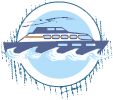
Dates & Prices
Prices From $4,050 / £3,293 per person
2025 prices, shared Ocean View Suite or Single
No single supplement for single Ocean View cabin
5 days: USD 4.050pp (low season)
7 days: USD 5,995pp (low season)
5 days: USD 4,660pp (high season)
7 days: USD 6,895pp (high season)
Ask us about promotional rates
Can’t find what you’re looking for? Get in Touch
+44 (0)131 378 5593
+44 (0)131 554 6025



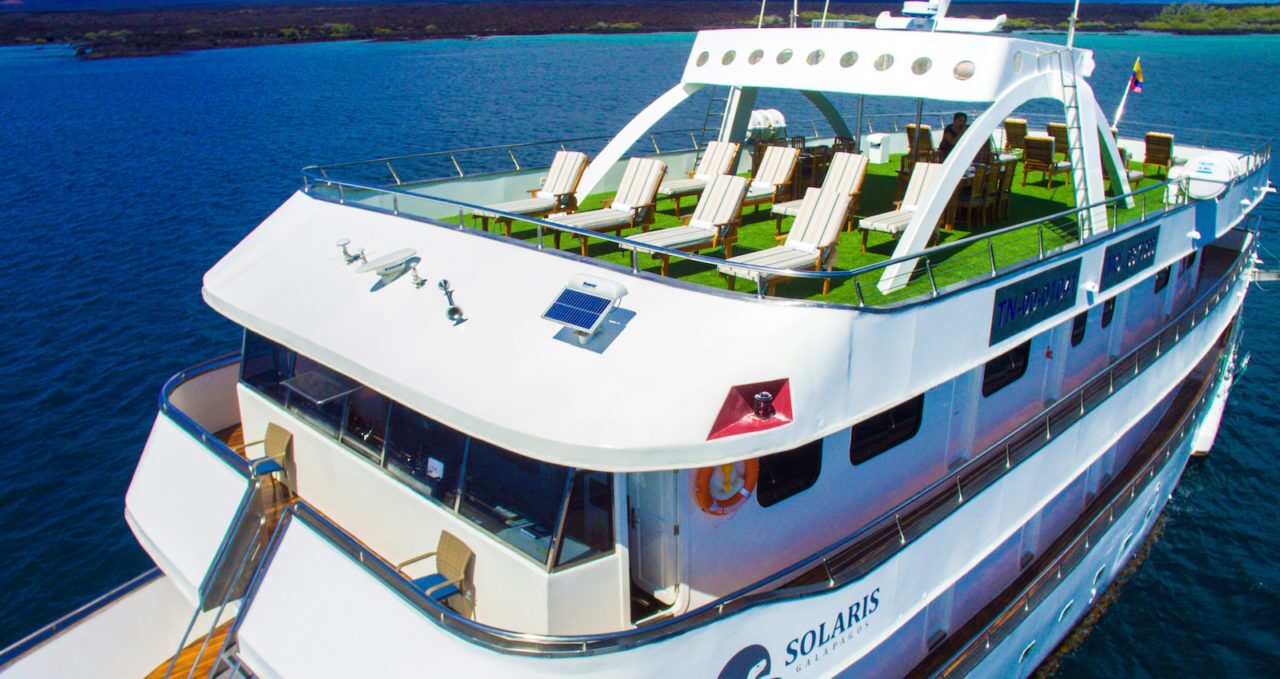
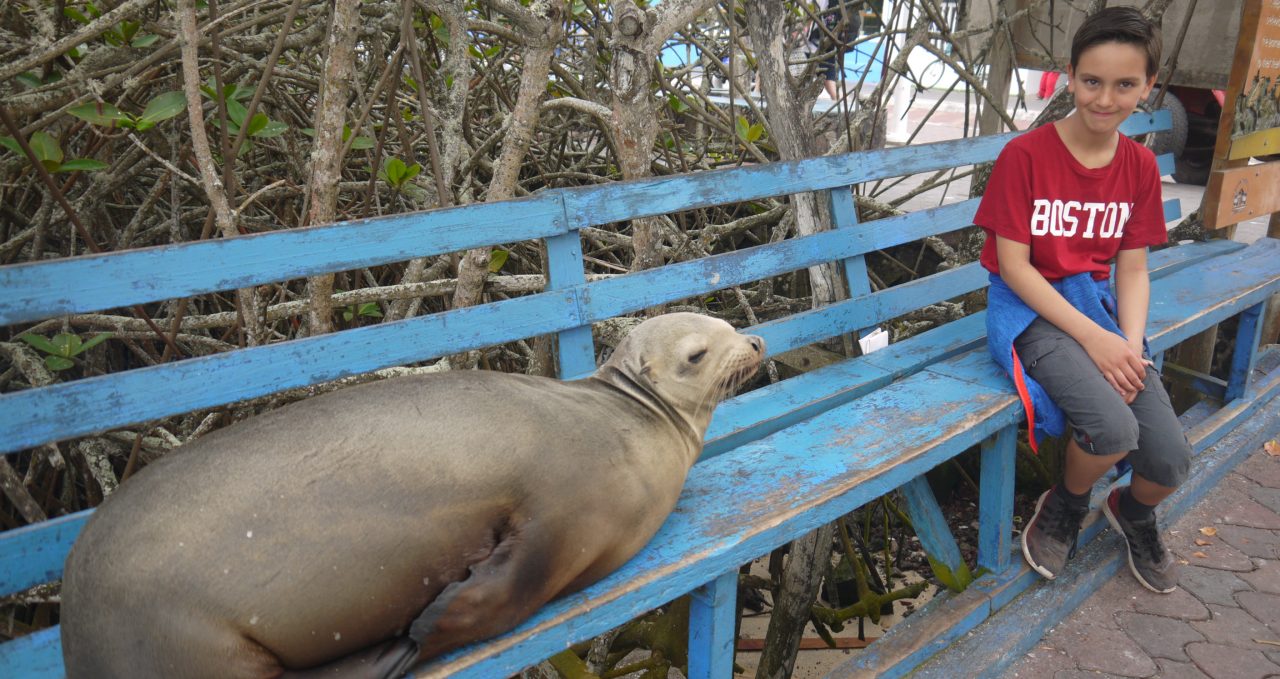
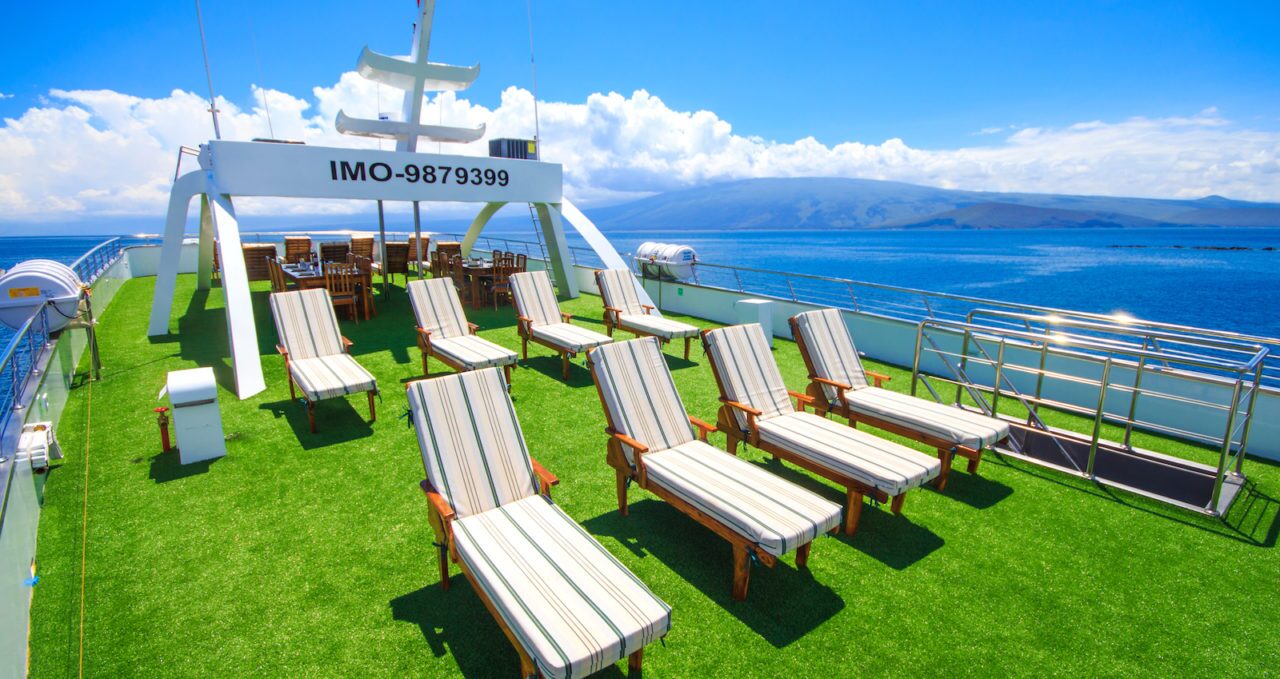
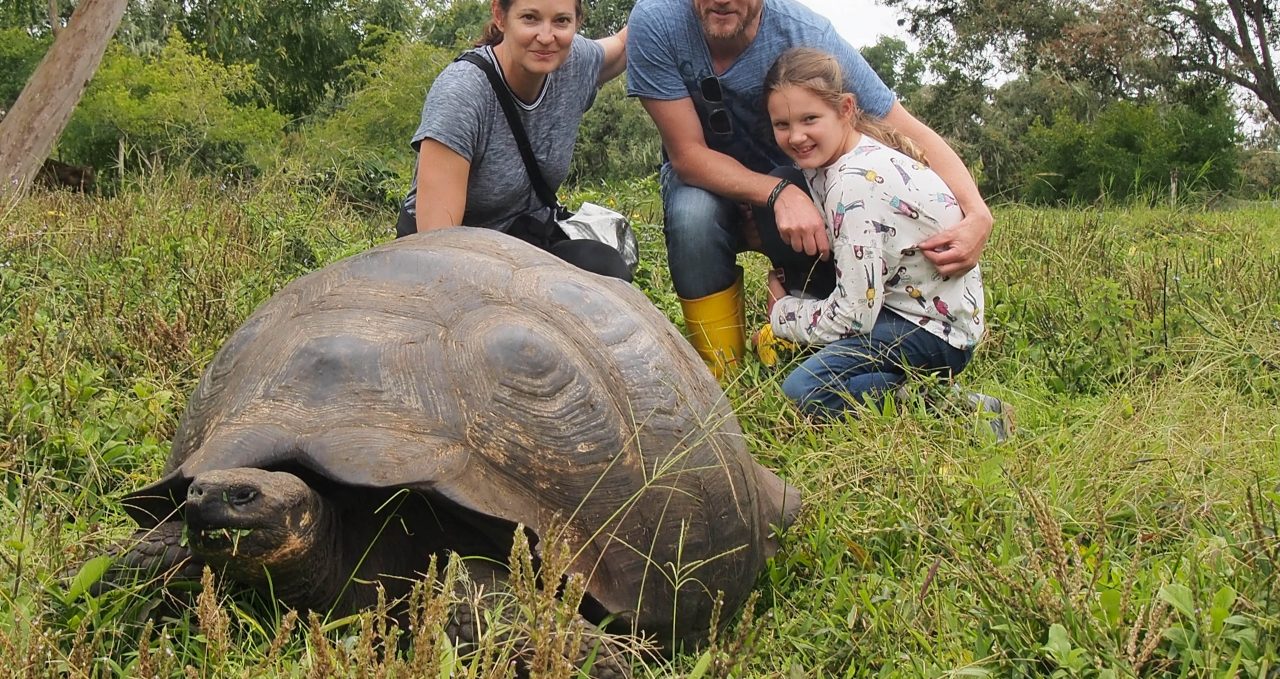
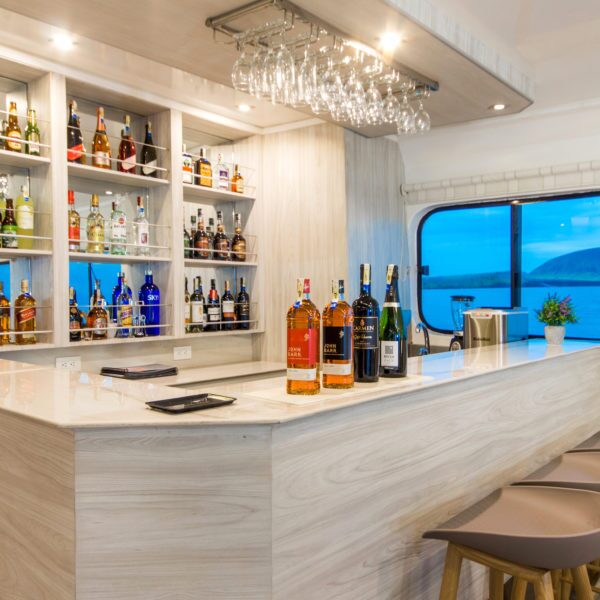
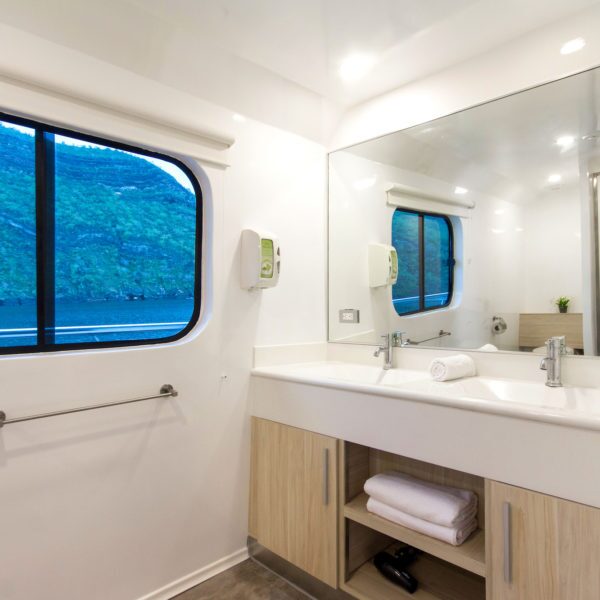
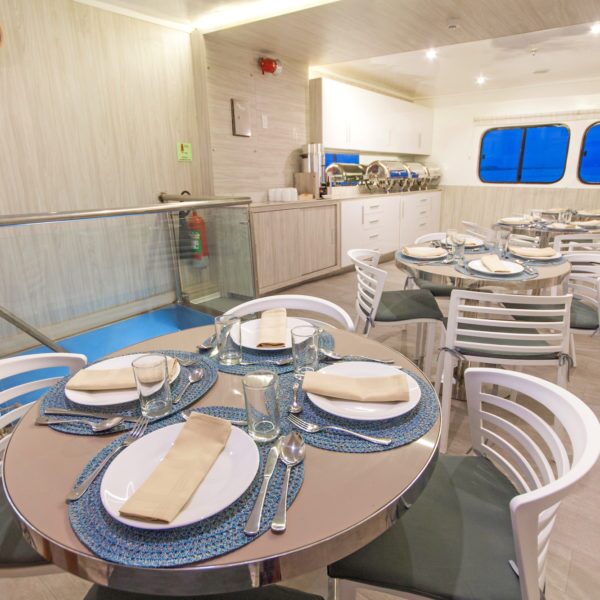
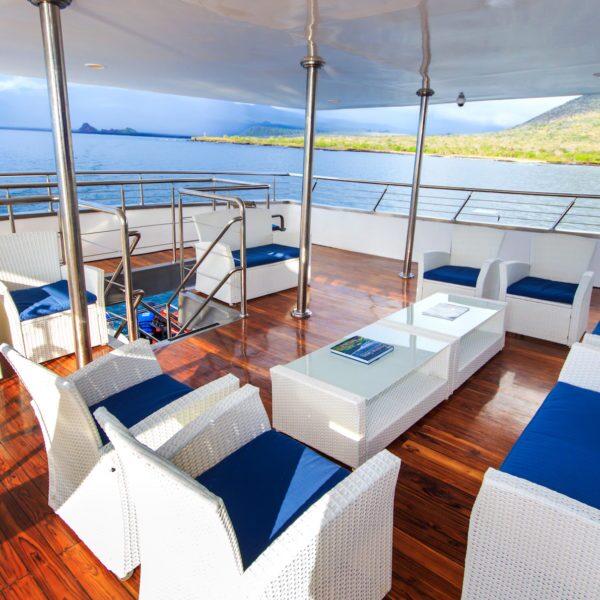
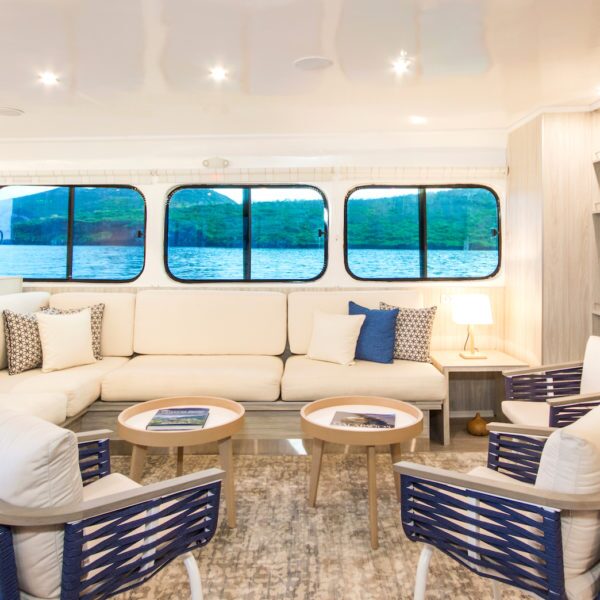
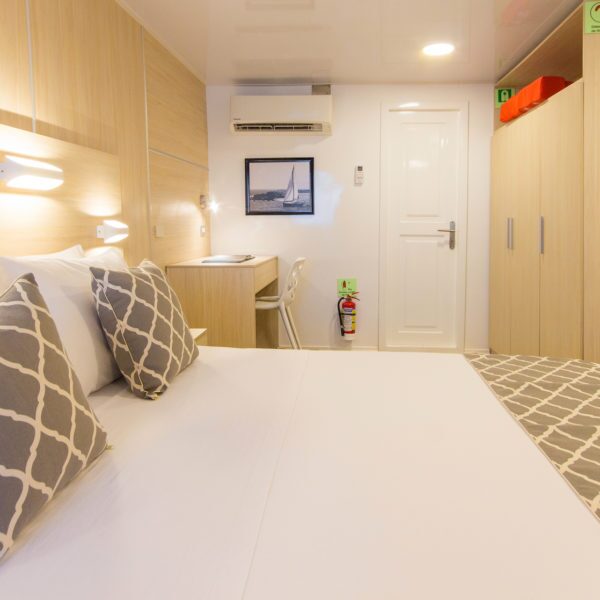
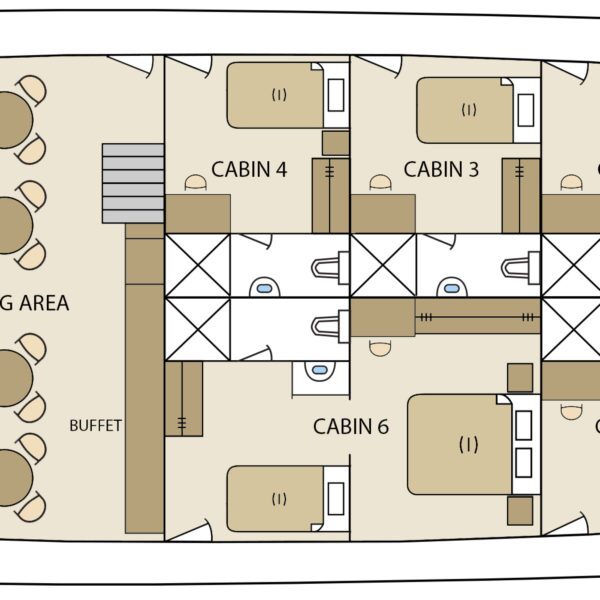
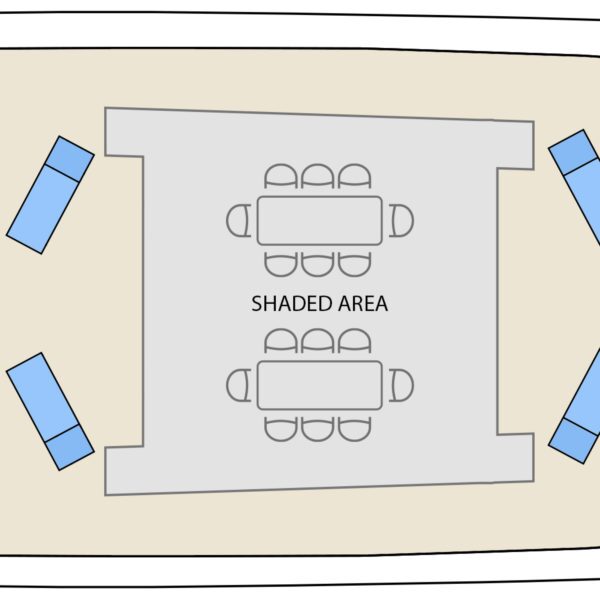
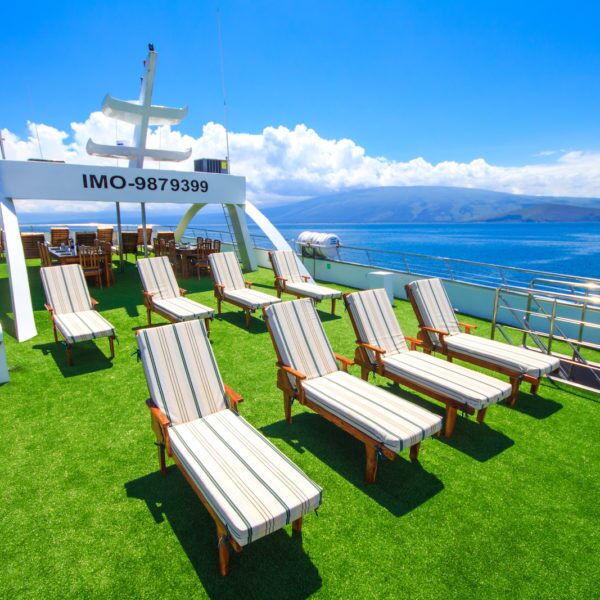
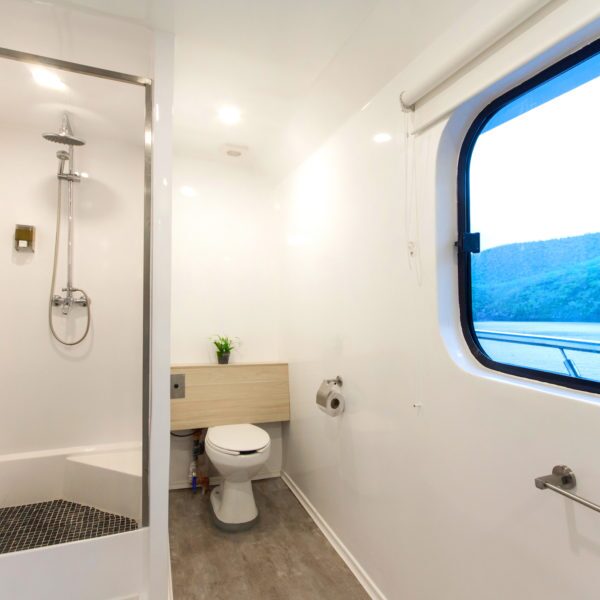
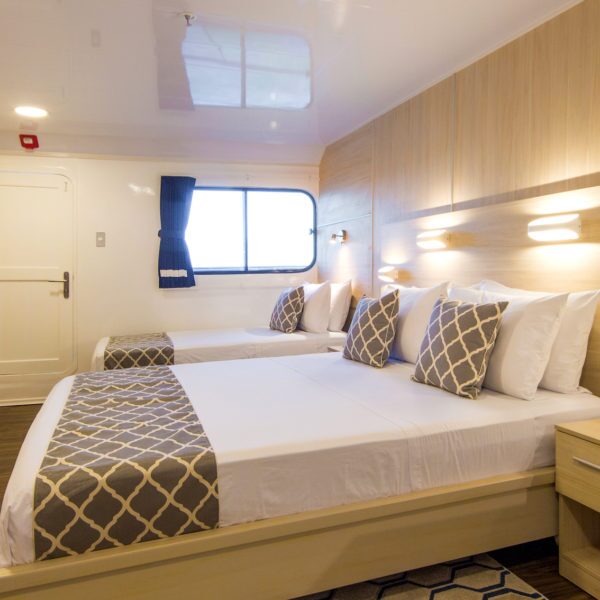
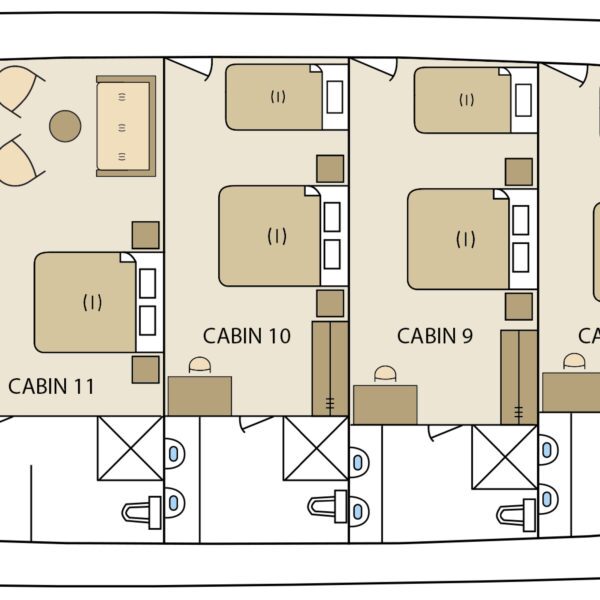
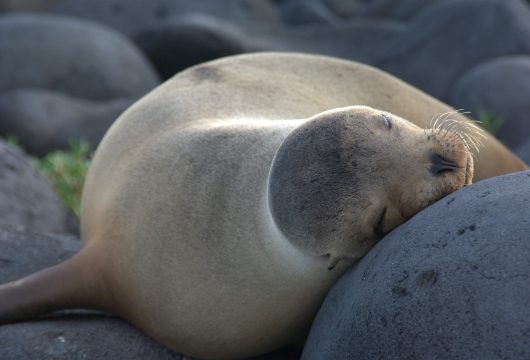
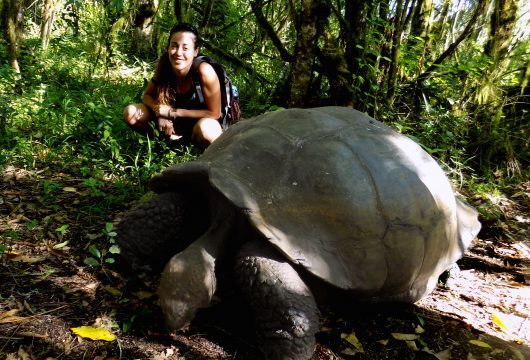
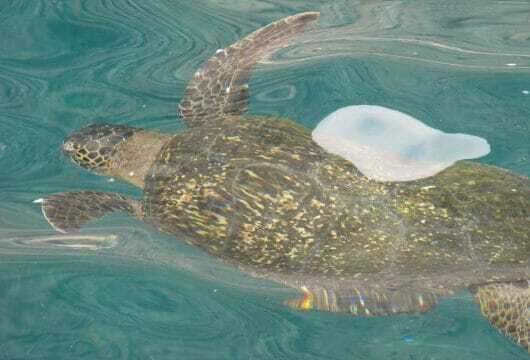
 a Group Tour
a Group Tour 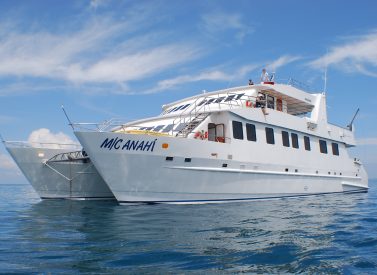
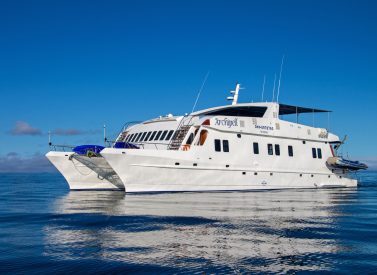
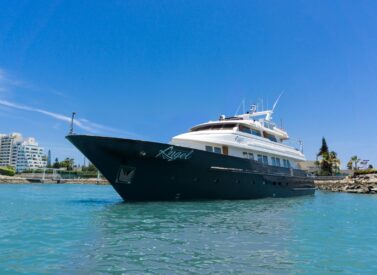
 a Tailor Made Tour
a Tailor Made Tour 